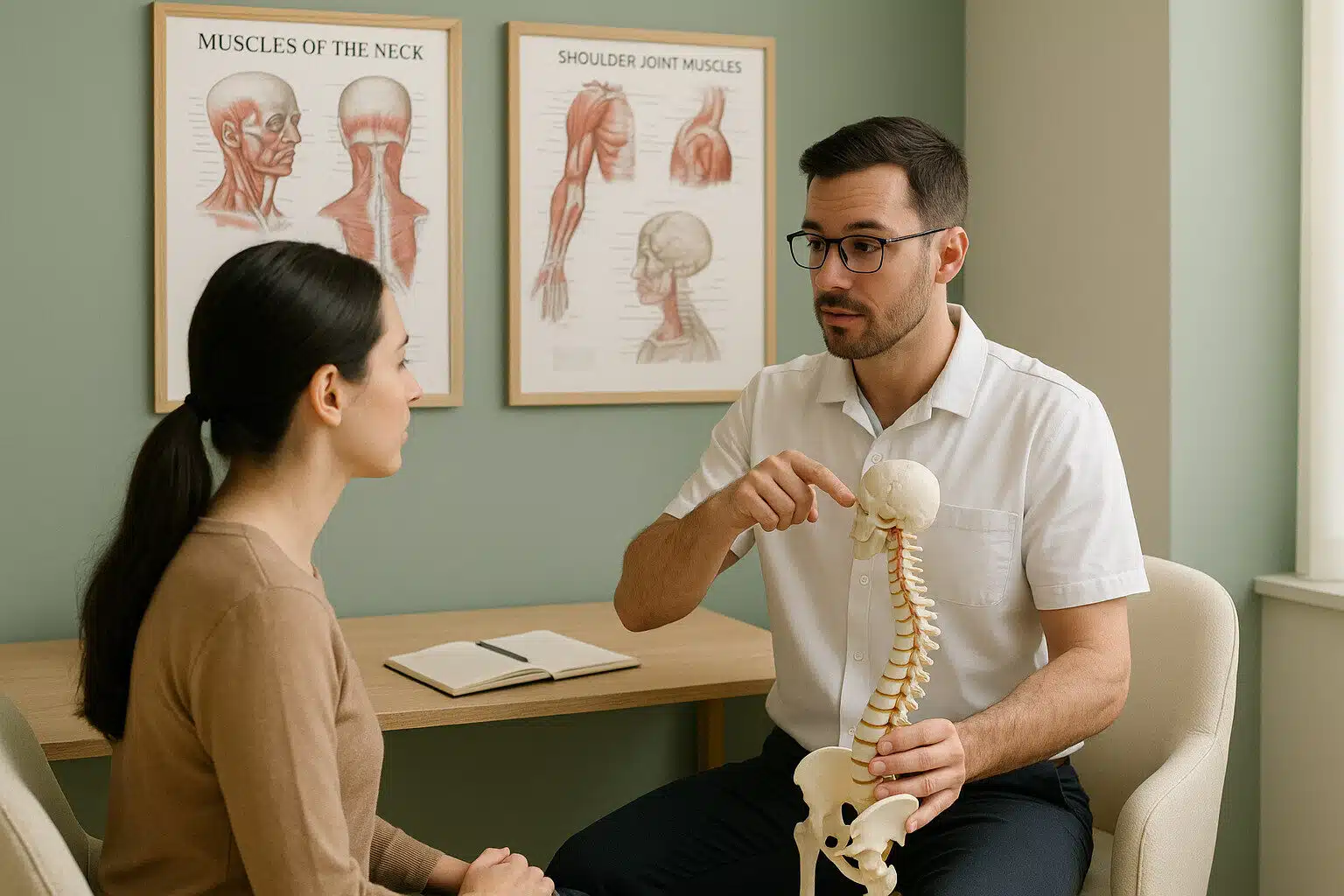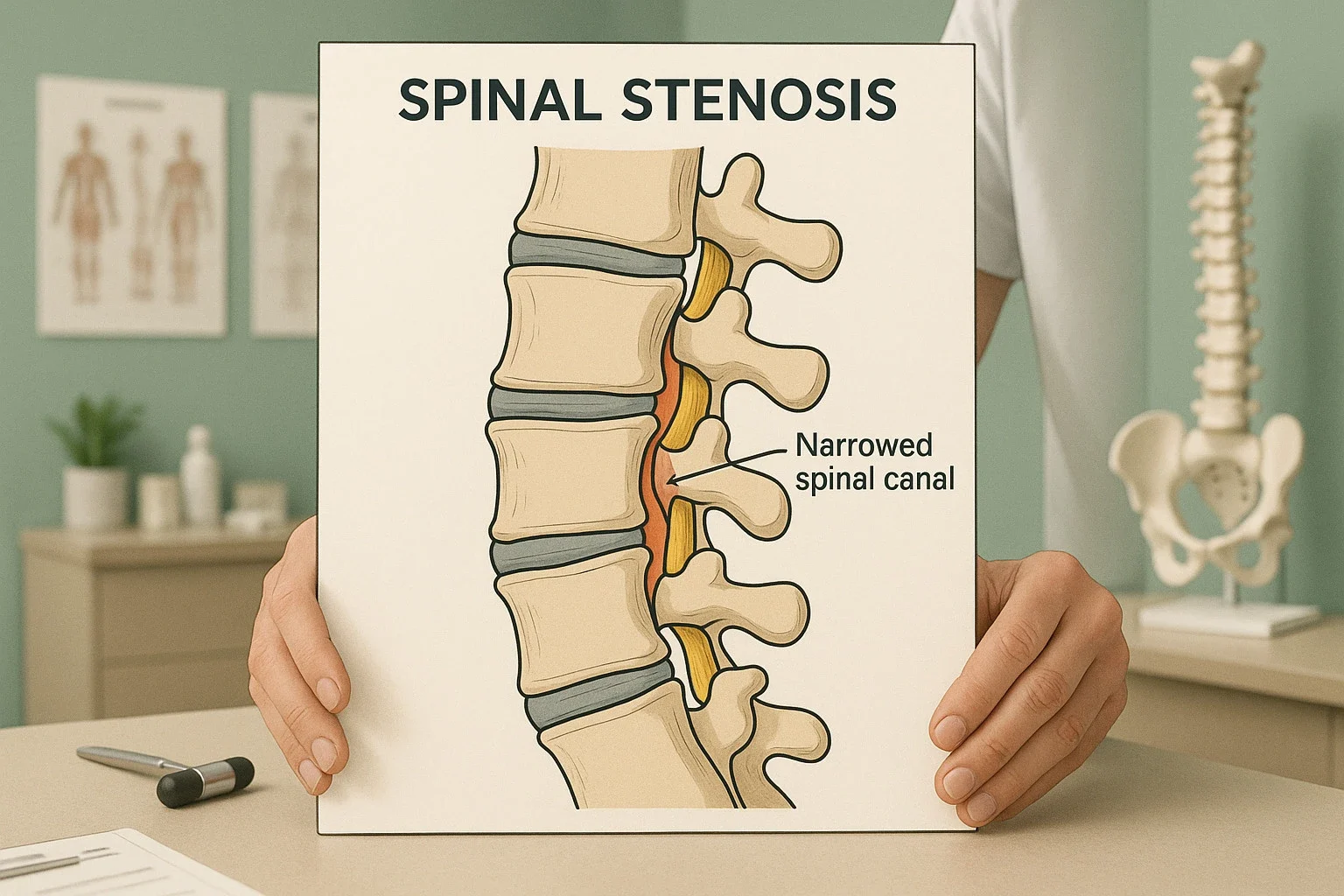Upper crossed syndrome affects countless people who spend hours hunched over computers, phones, and steering wheels. This common postural disorder creates a distinctive pattern of muscle imbalances that leads to chronic neck pain, headaches, and shoulder dysfunction. At Brooklyn Chiropractic Care, we see patients daily who struggle with the debilitating effects of this condition.
Understanding Upper Crossed Syndrome
Upper crossed syndrome represents a specific pattern of muscular imbalances characterized by tightness in the upper trapezius, levator scapulae, sternocleidomastoid, and pectoral muscles, coupled with weakness in the deep cervical flexors, lower trapezius, and serratus anterior[1]. This imbalance forms a ‘crossed’ pattern when viewed from the side, leading to forward head posture, increased cervical lordosis, thoracic hyperkyphosis, and protracted shoulders.
The condition develops from sustained poor posture during activities like computer use, driving, and smartphone usage, which create repetitive mechanical stress on cervicothoracic structures[6]. Modern lifestyle habits make upper crossed syndrome increasingly common, affecting both office workers and students alike.
Recognizing the Symptoms
Common symptoms include chronic neck pain (reported in 100% of cases), tension headaches, shoulder dysfunction, restricted cervical range of motion, and radicular symptoms in the upper extremities[6]. Secondary complications may include temporomandibular joint dysfunction, breathing pattern disorders, and even gastroesophageal reflux disease due to altered intra-abdominal pressure dynamics.
Postural deviations manifest visibly as rounded shoulders, forward head positioning exceeding 50° craniovertebral angle, and scapular winging[1]. Many patients don’t realize their poor posture and neck pain stem from this underlying syndrome until they receive a proper evaluation.
Key Takeaways
- Upper crossed syndrome creates a distinct pattern of tight and weak muscles
- Forward head posture is the primary visible sign
- Symptoms extend beyond neck pain to include headaches and breathing issues
- Early intervention prevents secondary complications
How Chiropractic Care Addresses Upper Crossed Syndrome
Multimodal chiropractic care demonstrates significant outcomes for upper crossed syndrome patients. HVLA thrust manipulation improves deep cervical flexor activation by 37%, corrective exercises reduce forward head angle by 11.2°, and soft tissue therapy decreases pressure pain thresholds in trigger points by 28%[9]. Longitudinal studies confirm sustained postural correction at 9-month follow-ups.
Our approach at Brooklyn Chiropractic Care includes spinal manipulation targeting C1-C2 and T1-T2 segments to restore proper joint movement, instrument-assisted soft tissue mobilization for hypertonic muscles, and neuromuscular re-education techniques[11]. Research confirms that combining cervical traction with corrective exercises yields superior outcomes compared to standard exercise protocols alone.
Evidence-Based Treatment Methods
Effective treatment requires a comprehensive approach targeting both the symptoms and underlying causes of upper crossed syndrome. Key interventions include:
- Spinal manipulation to restore normal joint function
- Soft tissue therapy to address muscle tension
- Postural correction exercises
- Ergonomic education and modifications
Our posture correction services specifically target the muscle imbalances characteristic of this syndrome, providing patients with both immediate relief and long-term solutions.
Home Management Strategies
Effective self-care incorporates specific exercises and lifestyle modifications. Chin tucks performed 5 times per hour during desk work help counteract forward head posture, while scapular retraction exercises with resistance bands (3 sets of 15 reps daily) strengthen weakened muscles[1]. Evidence supports 8 minutes of sustained postural correction using orthotics to induce neuromuscular re-education.
Ergonomic modifications prove crucial for long-term success. These include monitor elevation to eye level, proper keyboard and mouse positioning, and regular movement breaks throughout the day. Our ergonomic desk setup guide provides detailed recommendations for creating a posture-friendly workspace.
Prevention and Long-Term Management
Preventing upper crossed syndrome recurrence requires ongoing attention to posture and movement patterns. Patients benefit from regular chiropractic check-ups, consistent exercise routines, and workplace ergonomic assessments. Early intervention prevents the condition from progressing to more severe stages requiring intensive treatment.
Frequently Asked Questions
How long does it take to correct upper crossed syndrome?
Treatment duration varies based on severity and patient compliance. Most patients see improvements within 4-6 weeks, with significant postural changes occurring over 3-6 months of consistent care and exercise.
Can upper crossed syndrome be completely cured?
With proper treatment and lifestyle modifications, upper crossed syndrome can be effectively managed and symptoms dramatically reduced. However, maintaining good posture habits is essential for preventing recurrence.
What exercises help with upper crossed syndrome?
Key exercises include chin tucks, wall angels, scapular retractions, and deep neck flexor strengthening. A qualified chiropractor should evaluate your specific needs and prescribe appropriate exercises.
Is upper crossed syndrome related to tech neck?
Yes, tech neck is essentially a modern term for upper crossed syndrome caused by prolonged device use. Both conditions involve similar postural deviations and muscle imbalances.
Can upper crossed syndrome cause headaches?
Absolutely. The muscle tensions and postural changes associated with upper crossed syndrome frequently trigger tension headaches and cervicogenic headaches.
How can I prevent upper crossed syndrome at work?
Set up an ergonomic workstation, take frequent breaks, perform posture exercises throughout the day, and maintain awareness of your head and shoulder positioning.
Conclusion
Upper crossed syndrome represents a significant health challenge in our digital age, but effective chiropractic treatment offers hope for lasting relief. By addressing both the symptoms and underlying causes through comprehensive care, patients can overcome the pain and dysfunction associated with this condition. The key lies in early intervention, consistent treatment, and ongoing commitment to healthy postural habits.
Ready to find relief? Schedule an appointment online or visit us at Brooklyn Chiropractic Care, 112 Greenpoint Ave. STE 1B, Brooklyn, NY 11222. Experience relief, Embrace Wellness!
References
- Chang MC. Treatment of Upper Crossed Syndrome: A Narrative Review. J Clin Med. 2023;12(16):5392. doi:10.3390/jcm12165392
- Sahrmann S. Comprehensive corrective exercise program improves alignment, muscle activation and movement pattern in men with upper crossed syndrome. Sci Rep. 2020;10(1):20688. doi:10.1038/s41598-020-77571-4
- Ghan GM, Babu VS. Immediate Effect of Cervico-thoracic Mobilization on Deep Neck Flexors Strength in Individuals With Forward Head Posture: A Randomized Controlled Trial. J Chiropr Med. 2020;19(4):216-225. doi:10.1016/j.jcm.2020.07.002
- Harrison DE et al. A Comparison of Two Forward Head Posture Corrective Approaches in Elderly Patients With Non-specific Neck Pain. J Clin Med. 2023;12(2):615. doi:10.3390/jcm12020615


